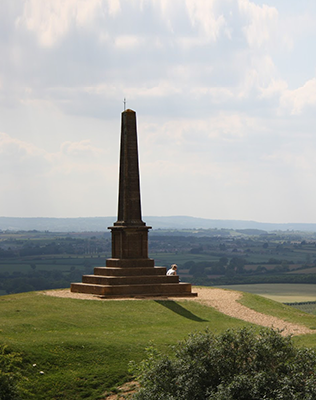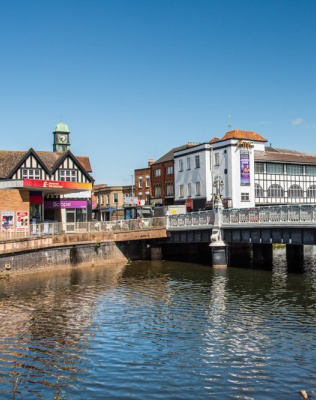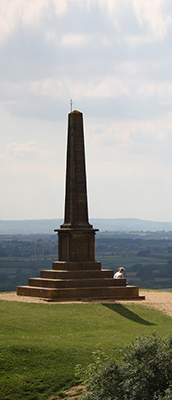Sofa Style

There are approximately 18 different sofa styles, some of which come with several different variants. Find out all about the different sofas you can get, including their characteristic design features.
There are many types of sofas out there - where to start?
For families you can’t beat a modern or sectional sofa as they are hard wearing, but if that doesn’t meet your aesthetics then there are lots more to choose from.
1. Chesterfield
The Chesterfield sofa is well known for its quilted or spotted style. Some have the tufted design only on the back and arms, while others also incorporate it on the bench section. It remains a popular style with current sofa trends.
History of the Chesterfield sofa
The Chesterfield sofa is believed to have been originally commissioned by Lord Philip Stanhope, the 4th Earl of Chesterfield in the 18th century. The Earl wanted a piece of furniture on which a gentleman could sit upright, so that he could sit comfortably.
Pictured: Duresta Connaught Grand Sofa
2. Lawson-style Sofa
This sofa style is designed to provide comfort. Its characteristic design element is a backrest made up of cushions separated from the frame. The reason for this construction is to create a softer, upholstered sofa with large cushions that are not tensioned within the sofa frame. It is still a popular sofa design today. You can buy a Lawson-style sofa in many sizes, colours and materials.
History of the Lawson sofa
The Lawson sofa is a relatively new design, the first to be designed in the early 20th century for financier Thomas W. Lawson. Thomas Lawson wanted a sofa which was modern in design and comfortable. Apparently, this is a derivative of the tuxedo sofa, a style which cover later in this article.
Pictured: Collins & Hayes Lavinia Sofa & Chair Collection
3. Mid-century Modern
From the 1930s to the 1970s, modern furniture was prevalent and now it is making a comeback. This sofa style is characterised by minimalist design and clean lines. There are many variations of this type of sofa and combined with the right interior design it can look fabulous.
History of the Mid-century Modern sofa
The Modernism design movement, which was popular from the mid-1930s to around the mid-1970s, epitomised elegance, functionality and simplicity. In her 1984 book "Mid-Century Modern: Furniture of the 1950s," Cara Greenberg became the first to officially name this style.
The style of Modernism in mid-century America can be traced back to earlier popular European styles such as the Bauhaus from Germany, which also influenced the American international style. When German designers emigrated to the United States during and after World War II, they brought their Bauhaus style with them. Moreover, the booming postwar economy created a class of affluent Americans who began to escape the inner cities and develop a unique suburban lifestyle. Their newly built homes required coordinated furnishing. Technological progress has also enabled the production of new materials such as plastics, plexiglass and lucite. Modern sofas and other mid-century furniture have clean lines and traditional and non-traditional materials, sometimes used in the same piece. It was not unusual to see the same basic style of the modern sofa from the mid-century in a selection of vinyl, wool or velvet.
Contrasting blacks, whites and colours from neutral to bold formed the simple geometric designs found in mid-century modern furniture. In addition, the newer materials facilitate care and maintenance unlike older styles that needed plumping several times a day.
Pictured: Ercol Marino Chair
4. Bridgewater
Casual and comfortable, the arms of a Bridgewater sofa are slightly curled to the side and are lower than the sofa backrest. Also known as birch arm or English three-seater, the Bridgewater sofa features a gently curled backrest, low, slightly curled arms, soft padded cushions and a distinctive tailored skirt that covers the legs. However, some contemporary pieces feature exposed legs.
Bridgewater is a traditional, casual and subtle sofa that does not overwhelm the rest of the furniture in the room. Like the English roll-arm sofa, the Bridgewater comes from the UK and is a good choice for those who want to preserve their furniture with a dust jacket. Typically, Bridgewater sofas can easily accommodate three people. Although this extremely comfortable sofa is especially popular as a casual sofa, it is versatile enough to fit into any decor. A neutral fabric allows bold pieces of art or other significant pieces to remain dominant. Velvet or rayon fabrics can complement a more traditional environment. Nail-head trim can also give a Bridgewater sofa a formal touch. A well-constructed Bridgewater sofa has high-quality springs in the interior to ensure comfort.
Pictured: Duresta Lansdowne Sofa
5. Camelback sofa
The main design feature of the Camelback sofa is a higher backrest in the middle, which falls in a continuous line into the arms of the sofa. There are also designs with two bows on the back. This type of sofa is also known for its exposed wood legs and often exposed wood on the back and arms. While a classic design, you can purchase contemporary camelback sofa designs which are more comfortable than the antique items.
History of the Camelback Sofa
The Camelback sofa, with its characteristic curved back, is a product of the late 17th century British furniture designer Thomas Chippendale. Chippendale was the first style of furniture to be named after its designer, not a reigning monarch. The English aristocracy came to prefer the camelback sofa for their homes, mainly because of Chippendale’s craftsmanship in a modified rococo style. Characteristics of this style included elegance, lightness, and emphasis on natural curves and ornaments.
The elegant camelback sofa, named after its camel humps, has tight upholstery, a shaped bench, high, curled arms for support and exposed legs. Authentic English camelback sofas feature claw-and-ball feet in the Queen Anne style. There are no separate back pillows. The traditional design of the Camelback makes it an ideal choice for placement between windows in a formal living room. Modern Camelback sofas often have one or two humps instead of three. Many contemporary camelback sofas are covered in bold, graphic prints that give an updated look to the traditional sofa.
Pictured: Tetrad Harris Tweed Sofa
6. Cabriole
The hallmark of the convertible sofa is a continuous, equally high back and arms. Often the arms bend inward and form a long line from arm to arm. Some designs contain ornate elements. However, more often (and especially in modern convertible sofas), ornate elements replace more comfortable elements, such as more cushions throughout the sofa. Cabrio sofas are also known for exposed wood panelling on the back and arms. However, there are contemporary Cabriole sofas in a classic convertible design without wood cladding.
7. Chaise Lounge
Chaise lounges are still popular, particularly in today's massive primary bedrooms and hotel suits. Some chaise lounges have one arm, while others have no arms. (The chaise lounge is also extremely popular as a terrace furniture, which is typically found by the pool).
History of the Chaise Lounge
Many believe that the first type of chaise longue was of Egyptian origin and was a combination of a chair and a day bed. Around 3000 BC the Egyptians built their primitive salons from palm stalks, which they secured with pieces of cowhide or cord. Later, wealthy Egyptians would lean back on wooden lounges. In ancient Greece, it became popular to recline on day beds instead of sitting at a table to drink or read. This piece of furniture consisted of layers of draped fabrics and pillows for headrests. The ancient Romans also used a kind of chaise longue, called a lectus, to lie down during meals and banquets. The chairs were made of wood and fitted with comfortable cushions.
The words "chaise longue" are derived from the French "chaise longue," which means "long chair." Chaise longue is simply a sofa in the shape of a long chair that can support itself structurally. The French chaise longue became popular in the 15th century. In the French Rococo era, the lounge was a social status symbol and was built from rare, expensive materials.
Modern chaise longue sofas are seen as a decorative addition rather than a necessary piece of furniture in the house and are usually found in a bedroom or other room where relaxation is the order of the day.
8. Sleeper Sofas
There are many sofa beds, ranging from pull-out sofas to futons and day beds to bunk bed sofa combinations. The most popular form of the sofa bed is the pull-out sofa bed. They have improved enormously compared to 30 years ago. Nowadays, sleeping beds are well designed and offer guests a great sleeping solution. A pull-out sofa bed differs from a futon in that the back of the sofa remains upright, while the sleeping surface folds under the belly of the sofa, from where it is stored and pulled out.
Convertible Sofas
A pull-out sofa differs from a pull-out bed in that it has no mattress. Depending on the quality of a mattress with a pull-out bed (the quality range is considerable) this can be more or less comfortable than a pull-out bed.
Futons
The futon is a sofa and bed combo. Generally, the backrest of the sofa folds down or unfolds to create a large, flat, padded sleeping surface. Similar to the futon, the sofa bed can also be folded down, consisting of pieces that fit together to form a large flat sleeping surface. The mattress consists of the cushions of the sofa. The convertible-style sleeper is often a feature of section sofas.
History of the futon sofa/bed
The history of futon goes back to seventeenth-century Japan; the word futon is derived from the Japanese word for bed linen. The Japanese stuffed cotton and wool and spread their bedding on rice straw or tatami floors, because the floor was so light, the mattresses had to be light and were therefore made of cotton with long stacks. The mattresses were even portable and could be rolled up and stored when they were not needed. At first, only the rich could afford the futon. However, with the advent of the Industrial Revolution and cotton production in the 17th century, all social classes gained access to bed linen.
American soldiers returning from the Far East after World War II described the comfort they experienced sleeping on the Japanese floor mattress. To accommodate the growing interest in such an exotic type of bed, American furniture manufacturers created a piece of furniture that combined both bed frames and mattresses according to certain Western preferences.
Daybeds
While it might not be cool to ask guests to sleep on a lounger, it can be a great place to put your feet up for a kip. The couch bed looks like a chaise longue, except that the couch has ends or back on each side. The problem with many loungers is that they do not offer much room for tall people, unless you do not mind putting your legs up.
Bunk Bed Sleepers
There is no question that children love them because children love heights as much as anything that changes. The bunk bed berth is a great solution for cabins and cottages or any residence where additional beds for children are needed.
Pictured: Helson 2 seater sofa bed with regal mattress
9. Loveseat Sofas
The loveseat sofa is a generic term for a sofa for two people. Often, they are part of a living room set. Like sofas, love seats come in many styles and can even be placed as a seat upon the end of a bed.
10. Divan
A divan is a sofa without a backrest. They must therefore be placed against a naked wall, against which cushions can be placed for a padded backAlthough they are not the most practical, because they are limited to where they can be placed, they offer a certain versatility in terms of pillow placement. You might like the look of a backless sofa (i.e. a padded bench) on the wall.
11. Settee Sofa
A settee is a broad chair. The nearest version today is the loveseat, but historically sofas have been narrower than deck chairs. They are also much less comfortable, as they are designed like a wide dining chair with arms, but they have an old-world charm. Indeed, they are suitable for beautiful foyer pieces.
12. Recliner Sofas
The recliner sofa is a fairly new type of couch but has gained popularity as it is great for watching TV and reading. Although not the best choice for a formal living room, they are perfect for family rooms and media rooms. In fact, with a little carpentry you can build a platform in a TV room and get two couches to create a fine media room for the home.
13. Tuxedo Sofas
A tuxedo sofa has high arms and the backrest cuts crosswise. It may not be the most comfortable, because it has no reclining angle, but it is a classy looking sofa with straight lines. The tuxedo design is also applied to deck chairs and chairs.
14. Low-Seated Sofas
Another particular type of sofa is a low-seated sofa that comprises several styles and can be used in different rooms such as living room, family room, bedroom and just about any room for lounging. The typical seating height of a sofa is between 17 "and 18." A low-seat sofa is one where the seat is lower than 17. "
15. Pallet Couches
Pallet furniture is popular and most people build it themselves, however, you can also buy some pallet furniture such as pallet sofas.
A pallet sofa is often built against the wall, with the back being the wall against which the cushions are placed. However, it is also possible to make a pallet sofa with its own backrest, so that it is slightly inclined, so that it is more comfortable than against the wall.
16. Sofa Loungers
What is a sofa lounger? It is a sofa with chaise longue design. It has been around for a while, but now it has its own concept. Basically, it is a sofa with an extension for putting up the feet.
a. Full sofa lounger
The full sofa is like a sofa bed, but you can still sit up in bed mode.
b. Multi-sofa lounger
The multi lounger is a sofa with more than one lounging extension.
c. Single sofa lounger
This is very common and is often referred to as a cut sofa. In reality, it is a sofa with a single chaise longue extension.
17. Corner Sofas
The section sofa is a multi-part sofa. It can be arranged in a range of configurations. The more parts, the more configurations. Ideally, each section you buy contains devices that connect the parts to prevent them from separating.
Due to the massive and growing popularity of corner sofas, there are many styles, designs and plush materials to choose from. Some are huge and can encompass large rooms, while others are much smaller. Two common configurations are L-shape and U-shape, to the left or right dominance.
History of the corner sofa
The sectional sofa became popular and developed in its present form in the 1950s, but corner sofas originated in the Victoria era. Early Victorian era corner sofas were primitive being two or more sofas that were pushed together to form a larger sofa. Corner separative sofas are great because they’re easy to place differently.
Pictured: Collins & Hayes Miller Corner Unit
- 26th January 2021




